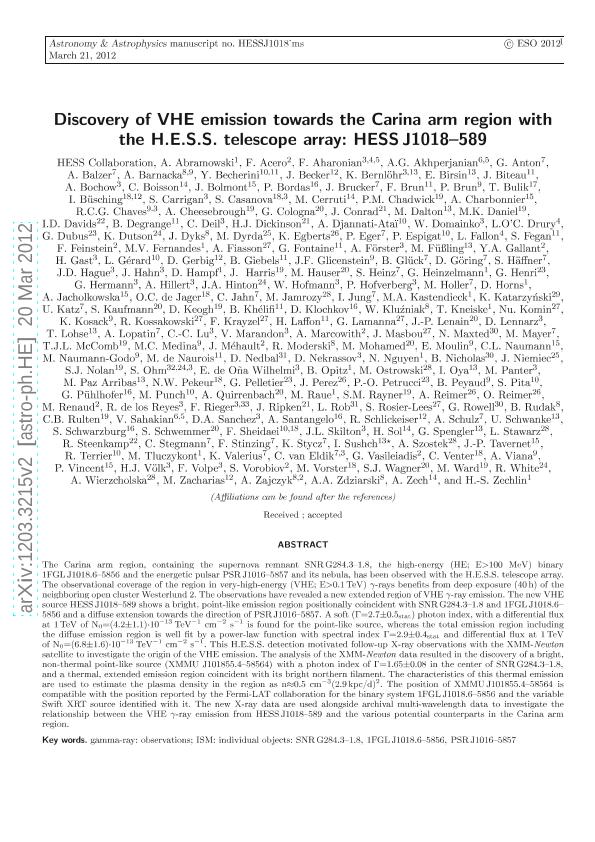Artículo
Discovery of VHE emission towards the Carina arm region with the H.E.S.S. telescope array: HESS J1018-589
Abramowski, A.; Acero, F.; Aharonian, Felix A.; Akhperjanian, A. G.; Anton, G.; Medina, Maria Clementina ; Spengler, G.; Stawarz, Ł.; Steenkamp, R.; Stegmann, C.; Stinzing, F.; Stycz, K.; Sushch, I.; Szostek, A.; Tavernet, J.-P.; Terrier, R.; Tluczykont, M.; Valerius, K.; van Eldik, C.; Vasileiadis, G.; Venter, C.; Viana, A.; Vincent, P.; Völk, H. J.; Volpe, F.; Vorobiov, S.; Vorster, M.; Wagner, S. J.; Ward, M.; White, R.; Wierzcholska, A.; Zacharias, M.; Zajczyk, A.; Zdziarski, A.; Zech, A.; Zechlin, H.-S.; H. E. S. S. Collaboration
; Spengler, G.; Stawarz, Ł.; Steenkamp, R.; Stegmann, C.; Stinzing, F.; Stycz, K.; Sushch, I.; Szostek, A.; Tavernet, J.-P.; Terrier, R.; Tluczykont, M.; Valerius, K.; van Eldik, C.; Vasileiadis, G.; Venter, C.; Viana, A.; Vincent, P.; Völk, H. J.; Volpe, F.; Vorobiov, S.; Vorster, M.; Wagner, S. J.; Ward, M.; White, R.; Wierzcholska, A.; Zacharias, M.; Zajczyk, A.; Zdziarski, A.; Zech, A.; Zechlin, H.-S.; H. E. S. S. Collaboration
 ; Spengler, G.; Stawarz, Ł.; Steenkamp, R.; Stegmann, C.; Stinzing, F.; Stycz, K.; Sushch, I.; Szostek, A.; Tavernet, J.-P.; Terrier, R.; Tluczykont, M.; Valerius, K.; van Eldik, C.; Vasileiadis, G.; Venter, C.; Viana, A.; Vincent, P.; Völk, H. J.; Volpe, F.; Vorobiov, S.; Vorster, M.; Wagner, S. J.; Ward, M.; White, R.; Wierzcholska, A.; Zacharias, M.; Zajczyk, A.; Zdziarski, A.; Zech, A.; Zechlin, H.-S.; H. E. S. S. Collaboration
; Spengler, G.; Stawarz, Ł.; Steenkamp, R.; Stegmann, C.; Stinzing, F.; Stycz, K.; Sushch, I.; Szostek, A.; Tavernet, J.-P.; Terrier, R.; Tluczykont, M.; Valerius, K.; van Eldik, C.; Vasileiadis, G.; Venter, C.; Viana, A.; Vincent, P.; Völk, H. J.; Volpe, F.; Vorobiov, S.; Vorster, M.; Wagner, S. J.; Ward, M.; White, R.; Wierzcholska, A.; Zacharias, M.; Zajczyk, A.; Zdziarski, A.; Zech, A.; Zechlin, H.-S.; H. E. S. S. Collaboration
Fecha de publicación:
05/2012
Editorial:
EDP Sciences
Revista:
Astronomy and Astrophysics
ISSN:
0004-6361
Idioma:
Inglés
Tipo de recurso:
Artículo publicado
Clasificación temática:
Resumen
The Carina arm region, containing the supernova remnant SNR G284.3-1.8, the high-energy (HE; E > 100 MeV) binary 1FGL J1018.6-5856 and the energetic pulsar PSR J1016-5857 and its nebula, has been observed with the H.E.S.S. telescope array. The observational coverage of the region in very-high-energy (VHE; E > 0.1 TeV) γ-rays benefits from deep exposure (40 h) of the neighboring open cluster Westerlund 2. The observations have revealed a new extended region of VHE γ-ray emission. The new VHE source HESS J1018-589 shows a bright, point-like emission region positionally coincident with SNR G284.3-1.8 and 1FGL J1018.6-5856 and a diffuse extension towards the direction of PSR J1016-5857. A soft (Γ = 2.7 ± 0.5stat)photon index, with a differential flux at 1 TeV of N0 = (4.2 ± 1.1) × 10-13 TeV^{-1} cm^{-2} s^{-1} is found for the point-like source, whereas the total emission region including the diffuse emission region is well fit by a power-law function with spectral index Γ = 2.9 ± 0.4stat and differential flux at 1 TeV of N_0 = (6.8 ± 1.6) × 10^{-13} TeV^{-1} cm^{-2} s^{-1}. This H.E.S.S. detection motivated follow-up X-ray observations with the XMM-Newton satellite to investigate the origin of the VHE emission. The analysis of the XMM-Newton data resulted in the discovery of a bright, non-thermal point-like source (XMMU J101855.4-58564) with a photon index of Γ = 1.65 ± 0.08 in the center of SNR G284.3-1.8, and a thermal, extended emission region coincident with its bright northern filament. The characteristics of this thermal emission are used to estimate the plasma density in the region as n ≈ 0.5 cm-3 (2.9 kpc/d)2. The position of XMMU J101855.4-58564 is compatible with the position reported by the Fermi-LAT collaboration for the binary system 1FGL J1018.6-5856 and the variable Swift XRT source identified with it. The new X-ray data are used alongside archival multi-wavelength data to investigate the relationship between the VHE γ-ray emission from HESS J1018-589 and the various potential counterparts in the Carina arm region.
Archivos asociados
Licencia
Identificadores
Colecciones
Articulos(IAR)
Articulos de INST.ARG.DE RADIOASTRONOMIA (I)
Articulos de INST.ARG.DE RADIOASTRONOMIA (I)
Citación
Abramowski, A.; Acero, F.; Aharonian, Felix A. ; Akhperjanian, A. G.; Anton, G.; et al.; Discovery of VHE emission towards the Carina arm region with the H.E.S.S. telescope array: HESS J1018-589; EDP Sciences; Astronomy and Astrophysics; 541; 5-2012; 5-10
Compartir
Altmétricas



